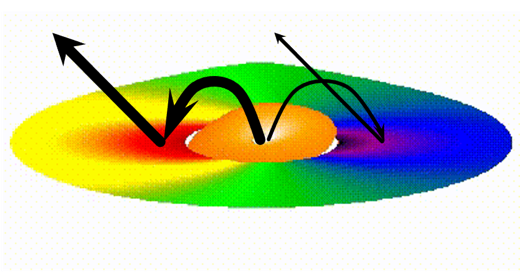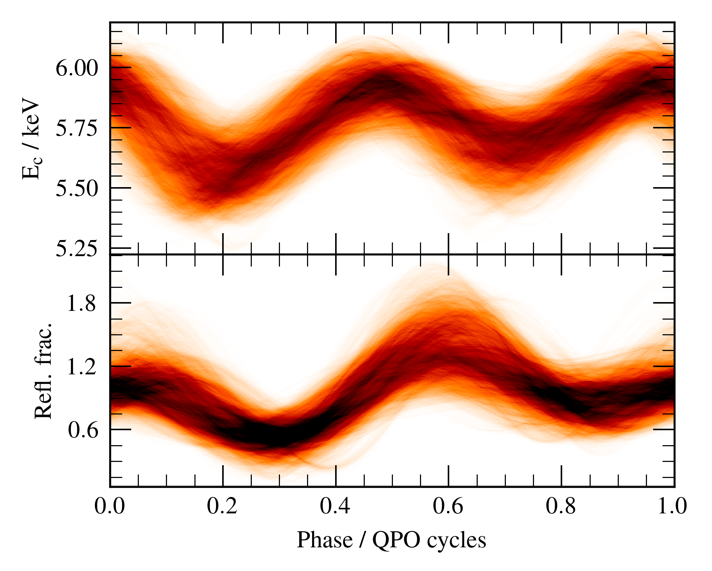NICER / ISS Science Nugget
for January 13, 2022
NICER Probes the Accretion Flow near a Black Hole
On June 8-9, 2018, NICER and NASA'a Nuclear Spectroscopic Telescope Array (NuSTAR) simultaneously observed the black hole X-ray binary (BHXRB) GRS 1915+105. Such systems consist of a black hole accreting gas from a companion star with which it is in a binary orbit. The goal of these observations was to improve our understanding of the geometry of the accretion flow close to the black hole in this system, by studying how the X-ray spectrum varies on very short timescales. We often see strong 'quasi-periodic' oscillations (QPOs) in BHXRBs on timescales of approximately one second; the origin of these signals largely remains a mystery.
A primary source of X-rays is thought to be a "corona" of hot plasma close to the black hole. Models suggest that the proximity of this gas to a spinning black hole may be causing the corona to precess, leading to nearly periodic variations in the X-rays that we detect. Some of these high-energy X-rays are also seen in reflection off the inner regions of the accretion disk; as a result, they highlight a prominent spectral line from iron atoms. The line is Doppler-shifted and broadened by the extreme relativistic conditions in the vicinity of the black hole: strong gravity and the very rapid orbital motion of the gas in the disk. The changing distortion of the iron line on short timescales helps map changes in the geometry of reflected X-rays from the disk, and thereby investigate how the corona is moving.
NICER's precise timing capabilities and its large collecting area allow the study of the short-timescale X-ray variability, probing strong quasi-periodic oscillations seen with a period of about half a second. These observations show how the X-ray spectrum changes throughout each cycle of this oscillation with novel Fourier techniques, to disentangle the reflected X-rays from those we see directly emitted from the corona.
The shape of the iron line varies in a way that is consistent with the corona's illumination profile onto the disk changing over the course of each QPO cycle. The overall amount of reflected X-rays does not vary in the same manner as those which we see directly from the corona; this is a key sign that the QPO is caused by the corona precessing, possibly due to its close proximity to a spinning black hole - as predicted by accretion models.
This work (titled "Phase-resolved spectroscopy of a quasi-periodic oscillation in the black hole X-ray binary GRS 1915+105 with NICER and NuSTAR"), led by graduate student Edward Nathan (Oxford Univ.) as part of his PhD thesis work, was recently accepted for publication in the journal Monthly Notices of the Royal Astronomical Society.



Figure: : Left & center: Illustrations showing how the corona, which may be a vertically extended hot flow in the innermost part of the accretion disk, may be precessing. At different phases of the QPO, the corona may preferentially illuminate parts of the disk that we observe (thick black arrows) to be either more blue- or red-shifted. Right, Top: A probability map showing how the observed energy of the iron line is changing over a cycle of the QPO. Usually at ~6.4 keV, the gravitational redshift imprinted by the black hole causes us to see the line at a lower energy. The variations in this energy come from the changing illumination of parts of the disk that are moving rapidly either towards or away from us. Right, Bottom: Changes in the relative amount of X-ray flux reflected off the disk over a QPO cycle. The variation of the change with phase strongly indicates a geometric origin of the QPO.
<< Previous
Main Index
Next >>